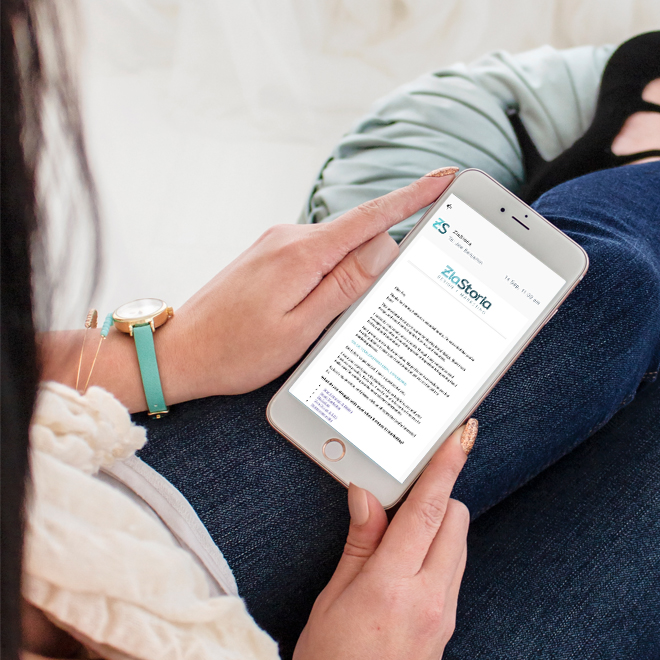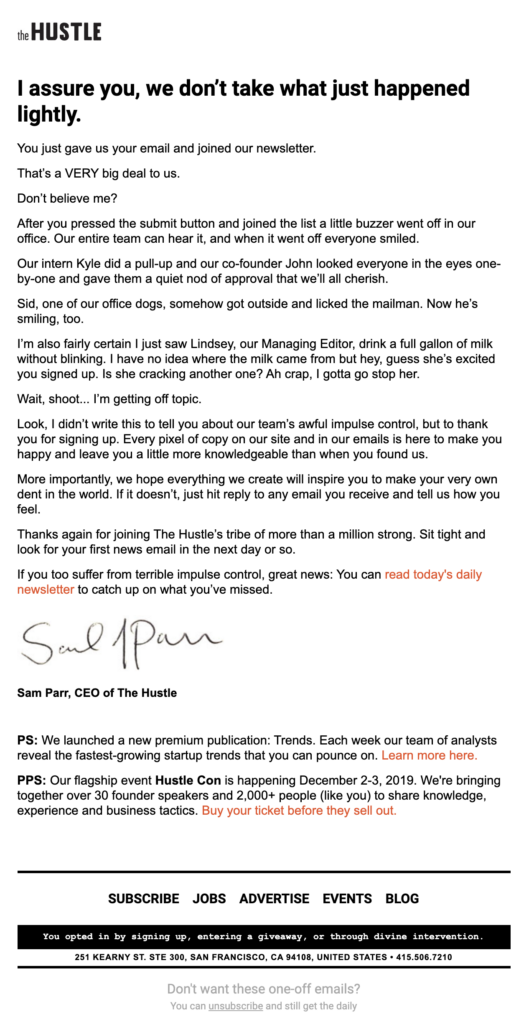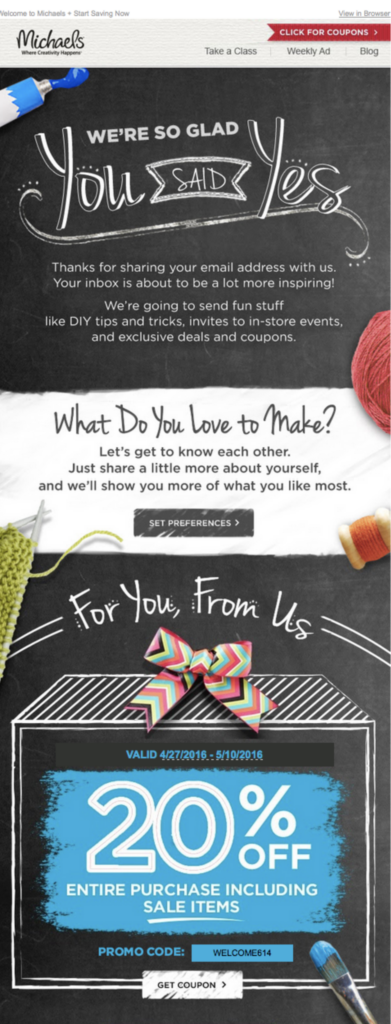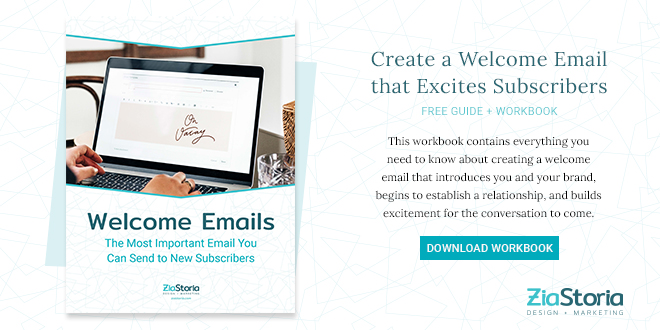SUBSCRIBE NOW
Join the Newsletter!
Entrepreneurship
Client Love
Marketing
Web Design
Email Marketing
Brand Design
Categories
Let's Connect
more about me
I help creative entrepreneurs and service providers create beautiful and effective strategic brands, websites, and email marketing programs.
owner + designer
I'm Tammy Hooker
Ciao!
Welcome Emails and Why You Need One

We’ve all received them. We sign up for a newsletter, and suddenly, a new email in our inbox – the sometimes mysterious, often robotic, welcome email.
Also known as an indoctrination series, welcome sequence, or onboarding sequence, your welcome email is your chance to make a great first impression to literally wow new subscribers at the front door. It’s so important that it may determine whether or not a subscriber engages with your future emails.
Just how important is it?
I see the long-term benefits of a welcome email in three ways.
Builds brand loyalty.
In saying thank you, you show your new subscribers that they aren’t just another random email address on your list. Through the welcome email, you can express how much you value their presence on your email list, and in doing so, you can start to build trust, which leads to increased brand loyalty.
Consider this stat – 74% of consumers expect a welcome email as soon as they subscribe to an email list (WordStream). So, if you aren’t already sending a welcome email, you’re failing to meet the expectations of 3 out of 4 new subscribers right out of the gate. That’s not a great way to start a new relationship.
Promotes higher engagement.
Beyond the initial interaction, new subscribers show the most engagement within the first 48 hours after subscribers (Experian Marketing Services). This means they’re primed to take action – whether that’s reading a blog post, downloading a freebie, signing up for a webinar, or buying a product.
Going beyond the first 48 hours, recipients of a welcome email show 33% more engagement with a brand (Experian Marketing Services). And higher engagement leads to increased sales.
Leads to increased sales.
Email marketing has the highest return on investment (ROI) of any marketing channel. It has an ROI of $36 for every $1 spent (HubSpot). Yet a welcome email is even more powerful as it can generate 320% more revenue per email than other marketing-related emails (Internet Marketing School). With numbers like that, having a welcome email seems like a no-brainer.
So, if you’ve heard about welcome emails but don’t have one or know how to put one together, this article is for you.
What is a welcome email?
On the technical side, a welcome email is an email that’s automatically sent to someone immediately after they join your list. You set it up within your email service provider (ESP), turn it on, and let it run in the background.
On the customer service side, think of your welcome email as the greeter at a restaurant, someone who smiles and formally welcomes a customer into your world.
But this greeter serves an even bigger purpose. Because turning over an email address to anyone, let alone a business, takes a huge amount of trust. Trust that you will respect the permissions a subscriber has just given you and that they will receive something equally beneficial in return. That’s the promise of email marketing.
Why is a welcome email important?
A welcome email is your chance to make a great first impression, to literally wow them at the front door.
With it, you can begin a relationship, build excitement, and start a conversation. It’s also an opportunity to train your subscribers so that when they receive your next email, they’ll WANT to open it.
If you’re a hard facts person, consider this. Welcome emails have an average open rate of 68.6% (GetResponse, 2022), while the average for regular marketing email sits at only 19.7%. That’s huge!
Your readers are expecting this email as a way to confirm their subscription. So take advantage of this expectation and deliver some valuable content simultaneously!
What’s not in a welcome email?
The list of what you can include in your welcome email is far longer than what you shouldn’t. So, let’s take a moment to discuss what you should not use your welcome email for, and that can be boiled down to two things: delivering incentives and sales/promotions.
Yes, in a way, these are the same thing. But let’s think of them as two separate, stand-alone items.
Incentives (freebies)
An incentive is something a subscriber has requested from you, usually a freebie that got them onto your list in the first place. It is, at its core, a financial transaction. The currency is their email address. The free product is the incentive. If a subscriber has joined your list to get an incentive, deliver that incentive in its own email, with copy tailored to the freebie (including a thank you) and any next steps they need to take – such as how to download the file.
For incentives, a subscriber would receive two emails sent immediately and automatically by your email service provider (ESP). The first is the email with the incentive/freebie. The second is the welcome email.
Sales/Promotions
Yes, email can be used to send promotions, announce new products, and drive sales. But when someone joins your list, they may not be ready to make a purchase. The welcome email (and a full welcome sequence) is the first step to a much longer relationship.
Think of it this way.
You go to a bar and strike up a conversation with the person next to you. They ask for your number (in our case, your email). The first time they call (email) you, they ask if you want to get married. What would you do? You’d hang up that call in a heartbeat and probably block their number.
In the email world, they’d unsubscribe from your list or, worse, mark you as spam. Why? Because it’s simply too soon in the relationship to make a sales pitch.
There is one exception to this rule – eCommerce businesses. A welcome email is a great place to offer a discount coupon/code expressed as a thank you. Welcome emails that contain an offer can boost revenue by 30% per email, compared to welcome emails without offers (Invespcro). But this offer should be presented as a side note, not a feature of the email. Remember, your subscriber is new and is still learning to trust you. This isn’t the time to pitch them more than a thank-you offer. If you do, you may spook them, and they may run.
For both of these situations – delivering incentives and sales/promotions – I think Ryan Deiss, co-founder and CEO of DigitalMarketer, says it best:
“We don’t make offers in an indoctrination series. We prescribe the next steps.”
So what’s your next step?
What goes into a welcome email?
Your welcome email is a simple thank-you letter at the most basic level. So, always start there. But the best welcome emails cover three things:
- a simple welcome and thank you message,
- restates what they’ve signed up for and how often you’ll be emailing them, and
- presents the next step the subscriber should take.
The first two are pretty straightforward. Say hello and thank them for signing up. Have fun with this part. Then, be sure to remind them why they joined your list – including what types of content you’ll be sending them and how often.
Most importantly, your welcome email should ask your subscriber to do something.
A next step might be anything from sharing a link to a popular blog post or an important page on your website that you think they’ll find helpful or entertaining, asking them to connect with you on social media, or asking them a question that they can answer by replying to your email.

This welcome email from The Hustle is one of my all-time favorites. Why? Because they had FUN with it! Now, 90% of this email is about #1 – the thank you. But toward the end, you get to #2 – restating expectations (first email coming in a day or so), and #3 – prescribing the next steps. And for this last one, they offer multiple options. First, they encourage feedback. Second, they point you to their latest daily newsletter. Lastly, they drop in two P.S. lines to promote other ways you can engage with their brand.
By prescribing a next step, you’re accomplishing several things.
First, in a way, you’re asking them to reconfirm their commitment to building a deeper relationship with your brand through your email list. Second, you’re providing them with additional value. A move that will gain you bonus points and help reinforce that subscribing was a good idea and that they should open your next email because you’re actually helpful or entertaining. And lastly, it encourages action. Persuading subscribers to take a desired action should be the goal of every email you send.
Here’s another great example from Michael’s.

This Michael’s welcome email functions as a mini website. It has navigation at the top, just like a traditional website, that links to high-value pages on their website. Then, they break the rest of the email down into three sections. The first section contains the thank you and restates what you can expect from their emails. The second section is the “next steps,” in which they ask subscribers to set their preferences so Michael’s can send them more emails containing projects the subscriber is interested in most. The last section circles back to the thank you in the form of a coupon code. While most would say they’re selling here, Michael’s isn’t in this instance. They’re saying thank you, with the added benefit of possibly making a sale off it.
Your welcome email doesn’t have to be complicated. But it should be gracious, helpful, and most of all – relevant and timely. This means making sure your welcome email’s content is evergreen.
What is evergreen email content?
In the simplest terms, evergreen content is content that doesn’t go out of date.
Your welcome email is a set-it-and-forget part of your email marketing program. You set it up once, turn it on, and let your ESP do the rest of the work.
Because this email runs in the background, and everyone joining your list receives the same one (no matter what day or time of year they subscribe), you must ensure the copy in your welcome email remains relevant for each new subscriber.
It’s static content. It doesn’t change or go out of date (very quickly), so it’s always current.
Track your welcome email’s performance
Now, that doesn’t mean you’ll never go in and change it. I encourage you to review your welcome email (and your entire welcome sequence) regularly to see how it’s performing.
Every month, you should log into your email program to see how many subscribers have joined your list, how many have received the welcome email, and if they’ve opened it and engaged with it (taken the action you want them to).
By tracking how your welcome email is doing, you’ll know when it’s time to make changes to the copy. For example, if new subscribers aren’t opening your email, you may need to tweak your subject line and preview text. Or suppose they’re opening emails but aren’t taking action. Look closely at the directions you’ve given them. You might need to rephrase your ask to make it more prominent or enticing.
Time to craft your welcome email
Now it’s your turn. Spend some time crafting your welcome email, one that creates a first impression new subscribers can’t help but connect with.
If you’re a newer business and don’t have a lot of pre-built resources (like blog posts) to share with your subscribers just yet, start with a single welcome email. Consider adding more emails to your sequence as your website and resources grow. But keep your full sequence between 5-7 emails. Any longer than that, and subscribers may start to lose interest.
Remember, your welcome email is the greeter welcoming new subscribers into your world. Make that first encounter one that doesn’t just say thank you but introduces you and your brand, begins to establish a relationship, and builds excitement for the conversations to come.
Need help writing your welcome email?
If you need help or are looking for examples, download my free Welcome Email Workbook. In it, you’ll discover the 8 points of an effective welcome email with examples. Plus, learn how to build a single welcome email or a full welcome sequence, complete with planning worksheets to help you map out your content and email flow.
let's do this!
let's build your brand a personality your customers will love!
Ready to infuse your brand with personality?
© 2025 | ZIASTORIA LLC | ALL RIGHTS RESERVED
est. 2021
contact
resources
blog
client portal
portfolio
about
Sign Up
Get my best tips, tricks, and how-tos delivered right to your inbox.
Join My Newsletter
ZiaStoria partners with creative entrepreneurs and service providers to craft brand designs, websites, and email marketing programs focused on connecting with customers and growing businesses.
Beautiful & Effective Brands
Email Marketing
Brand + Web Design
Brand Design
What can I help you with?
